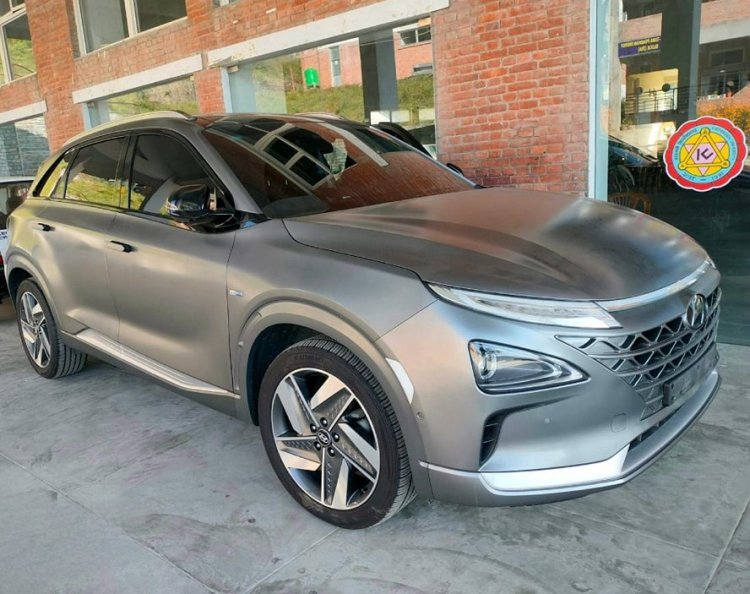Hydrogen Cars in Nepal: A Green Transportation Revolution
Unlock the future of transportation in Nepal with hydrogen cars. Discover the debut of Hyundai Nexo and delve into the eco-friendly revolution shaping the Himalayan nation's roads. Embrace sustainable journeys with hydrogen cars in Nepal.

In a pivotal moment for sustainable transportation, Nepal has stepped into the era of hydrogen-powered vehicles, marking a significant stride toward clean and eco-friendly mobility solutions. The advent of hydrogen cars in Nepal is spearheaded by the Green Hydrogen Lab under Kathmandu University, in collaboration with Nepal Oil Corporation. This comprehensive guide aims to delve into the world of hydrogen, exploring its production, applications, the groundbreaking introduction of hydrogen cars in the picturesque landscapes of Nepal, and the intriguing comparison between hydrogen and electric cars.
Understanding Hydrogen: The Fuel of the Future
Hydrogen Basics:
Hydrogen, the lightest and most abundant element in the universe, has emerged as a frontrunner in the quest for sustainable energy. Recognized for its versatility and minimal environmental impact, hydrogen serves as an ideal fuel source. In the context of transportation, it is harnessed as a clean energy alternative to conventional fossil fuels.
Hydrogen Production:
- Green Hydrogen Production: The Green Hydrogen Lab focuses on green hydrogen, produced through electrolysis. This process involves splitting water into hydrogen and oxygen using renewable energy, such as hydropower. With Nepal's surplus hydropower potential, green hydrogen production becomes a viable and eco-friendly solutions.
- Challenges in Hydrogen Storage and Distribution: Despite its potential, the storage and distribution of hydrogen pose challenges due to its low density. Compression or liquefaction is required to reduce volume, enabling efficient transportation. Overcoming these challenges is crucial for the widespread adoption of hydrogen-powered vehicles.
Hyundai Nexo: Pioneering Hydrogen-Powered Transportation in Nepal
Hyundai Nexo: A Revolutionary Fuel-Cell Electric Vehicle (FCEV):
The introduction of hydrogen cars in Nepal is epitomized by the Hyundai Nexo, a cutting-edge Fuel-Cell Electric Vehicle (FCEV). Hyundai's Nexo stands as a symbol of innovation and sustainability, emitting only water vapor as a by-product of the chemical reaction between hydrogen and oxygen. With an impressive driving range of up to 666 kilometers, the Nexo is a trailblazer in clean and efficient mobility.
Technical Collaboration and Innovation:
Technical support from Nepal Oil Corporation has played a pivotal role in the realization of hydrogen-powered transportation in Nepal. The collaboration between Kathmandu University and Nepal Oil Corporation underscores the importance of interdisciplinary efforts in advancing sustainable energy solutions.
The Feasibility of Hydrogen Cars in Nepal
Research Initiatives and Test-Drive Opportunities
Kathmandu University's Green Hydrogen Lab has been at the forefront of research initiatives exploring the feasibility of hydrogen-powered vehicles in Nepal. Approximately three years ago, an agreement between Nepal Oil Corporation and Kathmandu University laid the foundation for this research, supported by a substantial pledge of Rs 5 crore. The Hyundai Nexo is not only a symbol of technological advancement but also an opportunity for the public to engage with the future of transportation through test drives at Kathmandu University.
Immediate Applications and Potential Sectors
- Chemical Industry: The immediate focus lies on the chemical industry, with the production of ammonium-based fertilizers, including urea, using green hydrogen. The surplus hydropower in Nepal positions the country to address chronic fertilizer shortages, simultaneously reducing dependency on imports.
- Iron and Steel Industry: A medium-term prospect involves leveraging green hydrogen in the iron and steel industry. Although the technology for hydrogen-based steel production is commercially available, specific infrastructure investments are required for its implementation.
- Transportation: In the long term, Nepal can explore the application of green hydrogen in the transportation sector, especially for heavy vehicles like trucks and ships. Hydrogen-based Fuel Cell Electric Vehicles (FCEVs) are evolving, with anticipated growth in the market size by 2030.
- Residential Use: The residential use of green hydrogen for heating and cooking is a long-term prospect. Although the technology is in the early stages, global advancements in this area pave the way for future applications in Nepal.
Hydrogen Cars vs Electric Cars: Navigating the Choices in Nepal
Hydrogen Cars: A Glimpse into the Future
Hydrogen cars, epitomized by the Hyundai Nexo in Nepal, operate on fuel cells where hydrogen reacts with oxygen to produce electricity, emitting only water vapor. The advantages include rapid refueling and long ranges, but challenges lie in infrastructure development and hydrogen storage.
Electric Cars: The Current Standard
Electric cars have gained widespread popularity globally. These vehicles rely on battery technology to store and use electricity, offering advantages like lower maintenance costs and a developed charging infrastructure. However, range limitations and longer charging times pose challenges.
Hydrogen vs Electric: Pros and Cons
- Charging Time: Hydrogen cars offer quick refueling, contrasting with the longer charging times associated with electric cars.
- Range: Hydrogen cars typically have a longer range per refuel compared to electric cars, providing an edge for long-distance travel.
- Infrastructure: Electric cars benefit from an established charging infrastructure, while hydrogen cars require substantial infrastructure development.
- Emissions: Both technologies boast minimal emissions, but hydrogen cars emit only water vapor, contributing to cleaner air.
The Socio-Economic Impact of Hydrogen Cars in Nepal
Agricultural Sector Boost:
The immediate application of green hydrogen in the chemical industry, particularly for the production of fertilizers, holds immense significance for Nepal's agricultural sector. With agriculture contributing significantly to the GDP and supporting a majority of the population, the availability of domestically produced fertilizers enhances productivity and income for farmers.
Economic Transformation:
Hydrogen's role in the iron and steel industry signifies a potential economic transformation. While initial investments are required, the long-term benefits include reduced environmental impact and increased sustainability.
Governmental Support and Policy Advocacy:
The successful integration of hydrogen cars into Nepal's transportation landscape requires proactive governmental support and the formulation of policies conducive to the adoption of alternative fuels. Addressing legal hurdles, such as defining hydrogen as a fuel and establishing regulations, is crucial for commercial viability.
Looking Ahead: A Roadmap for Nepal's Hydrogen-Powered Future
As Nepal embraces the era of hydrogen-powered transportation, a roadmap for the future must consider the immediate, medium-term, and long-term applications of green hydrogen. Infrastructure development, technological advancements, and policy frameworks play pivotal roles in steering Nepal toward a sustainable and eco-friendly transportation landscape.
Immediate Focus Areas:
- Chemical Industry Applications: Prioritize the production of ammonium-based fertilizers using green hydrogen to address immediate agricultural needs.
- Technological Integration: Explore advancements in hydrogen technology, particularly in the transportation sector, through collaborations with international innovators and research institutions.
- Public Awareness: Foster awareness programs to educate the public about the benefits and potential of hydrogen-powered vehicles, emphasizing the role of citizens in driving sustainable change.
Medium-Term Prospects:
- Iron and Steel Industry Integration: Invest in infrastructure for hydrogen-based steel production, positioning Nepal as a pioneer in sustainable practices within the industry.
- Transportation Sector Expansion: Develop hydrogen refueling stations and incentivize the adoption of hydrogen-powered vehicles, especially in the commercial transportation sector.
- Governmental Policy Development: Collaborate with stakeholders to establish clear policies that define hydrogen as a recognized fuel, addressing legal complexities and facilitating commercial viability.
Long-Term Vision:
- Technological Advancements: Embrace global advancements in hydrogen technology, such as advancements in fuel cell efficiency and storage solutions, to continually improve the performance and accessibility of hydrogen-powered vehicles.
- Diversification of Applications: Explore additional sectors for hydrogen applications, such as residential use, as technology matures and safety concerns are adequately addressed.
- International Collaboration: Foster collaborations with countries leading in hydrogen technology to exchange knowledge, promote research initiatives, and collectively contribute to the global transition to sustainable energy.
Conclusion:
As the wheels of hydrogen-powered vehicles make their debut on Nepali roads, the nation stands at the forefront of a transformative journey towards sustainable and clean transportation. The introduction of the Hyundai Nexo and the ongoing research initiatives at the Green Hydrogen Lab mark the beginning of a new era, where Nepal positions itself as a regional leader in adopting green hydrogen technology.
The comparison between hydrogen and electric cars highlights the diverse choices available, each with its unique advantages and challenges. While electric cars currently dominate the market, hydrogen cars bring a promising alternative that could revolutionize long-distance travel and heavy-duty transportation.
Nepal's socio-economic landscape stands to benefit significantly from the integration of hydrogen technology. From addressing agricultural needs with locally produced fertilizers to ushering in economic transformations in heavy industries, the impact is far-reaching. However, the realization of this potential hinges on robust governmental support, policy frameworks, and active participation from both the public and private sectors.
The roadmap for Nepal's hydrogen-powered future requires a strategic and phased approach. Immediate applications in sectors like the chemical industry pave the way for broader adoption, while medium-term prospects in transportation and heavy industries set the stage for long-term sustainability.
As Nepal navigates the road to sustainable transportation, the collaboration between academia, industry, and government becomes paramount. By fostering innovation, raising public awareness, and embracing international collaboration, Nepal can not only embrace hydrogen as a fuel but also emerge as a regional hub for clean energy solutions.
In the pursuit of a greener future, Nepal's embrace of hydrogen-powered cars is not just a technological leap but a commitment to environmental stewardship and a sustainable tomorrow. With each hydrogen-powered vehicle, Nepal accelerates towards a future where clean energy powers the nation's progress. As the wheels of hydrogen-powered vehicles roll on Nepali roads, they carry the promise of a brighter, cleaner, and more sustainable tomorrow.
What's Your Reaction?





































































































